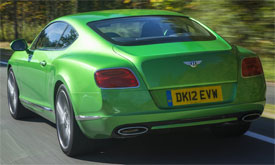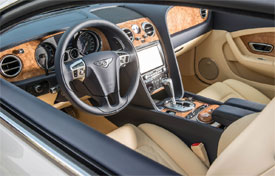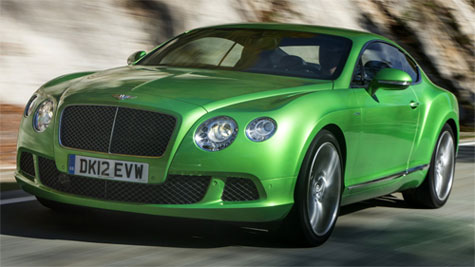2013 Bentley Continental GT Speed
While the pursuit of speed has been around for much longer than the automobile itself; when the internal combustion engine first merged with 4 wheels that search greatly intensified. Now fast-forward to this latest Bentley Continental GT, not only does it ooze sex appeal and extravagance, but it’s the fastest Bentley ever. And it’s fittingly called… the GT Speed.
 What’s in a name? Well, as Speed is in the name of the 2013 Bentley Continental GT Speed, it’s clear that that’s what this car is all about. As its top speed of 205 miles-per-hour, is indeed 1 mile-per-hour faster than the Bentley Continental Supersports. And while there are no public roads in this country where you can actually do that legally, just knowing that you can is enough for most people.
What’s in a name? Well, as Speed is in the name of the 2013 Bentley Continental GT Speed, it’s clear that that’s what this car is all about. As its top speed of 205 miles-per-hour, is indeed 1 mile-per-hour faster than the Bentley Continental Supersports. And while there are no public roads in this country where you can actually do that legally, just knowing that you can is enough for most people.
Making the speed possible is a slight tweaking of the Continental’s 6.0-liter twin-turbo W12 engine. Turbo pressure is boosted to 28 psi, and the ECU gets reprogrammed to manage it. The result is 616-horsepower and an even more impressive 590 lb-ft. of torque.
Exterior tweaks to the GT Speed are subtle, but like any luxury item, those “in the know” will quickly spot the 21-inch split-spoke wheels and the darker finish to the front air intakes. And those that aren’t “in the know” can appreciate the new chrome trim around the tail lights and unique rifled exhaust tips as you streak past them. And if our car’s flaming orange paint job is not ostentatious enough, Bentley will be happy to mix up a custom color just for you; as in Crewe, all things are possible for a price.
 Streaking down the track like a freight train out of control, the GT Speed reaches the end of the ¼ in just 12.1-seconds and 119 miles per hour, and it feels like it’s just getting started. With Speed in the name it had better bring it, and it surely does as it leaps off the line with authority and, thanks to all-wheel-drive, no wheel spin, launching to 60 in just 4-seconds flat.
Streaking down the track like a freight train out of control, the GT Speed reaches the end of the ¼ in just 12.1-seconds and 119 miles per hour, and it feels like it’s just getting started. With Speed in the name it had better bring it, and it surely does as it leaps off the line with authority and, thanks to all-wheel-drive, no wheel spin, launching to 60 in just 4-seconds flat.
It sounds mean under full throttle, but still not as aggressive as the V8 Continental. With almost 16-feet of length and over 600-horsepower connected to your right foot, navigating through the cones is an exercise in restraint. Initiating the Speed’s Dynamic Mode helps a little.
But unless you have your own private race track, most of your time will be spent at more sedate speeds, and that is where this Continental really impresses; with a smooth manner and solid ride that can only be found in cars of a certain exclusivity. This basic chassis has been around for a while now and we love it just as much now as we did when it first appeared. It has spawned some great automotive machinery over the years, but this one’s the best yet.
 Inside, the feel is still incredibly “high end”, but there’s still a decidedly sporty turn with a perforated leather headliner, turned metal trim, metal pedals, and color stitching throughout the cabin. There’s something for almost every sense to enjoy, whether it’s the feel of the controls, the smell of the leather, or the sounds coming from the 11-hundred watt “naim” audio system. The front seats look great and provide both incredible comfort and support.
Inside, the feel is still incredibly “high end”, but there’s still a decidedly sporty turn with a perforated leather headliner, turned metal trim, metal pedals, and color stitching throughout the cabin. There’s something for almost every sense to enjoy, whether it’s the feel of the controls, the smell of the leather, or the sounds coming from the 11-hundred watt “naim” audio system. The front seats look great and provide both incredible comfort and support.
If there’s any bad news to report, it’s that the Speed will cost you a trust fund busting $215,000. At that price, there are quite a few options out there; most of which are actually more entertaining to drive. But none can touch the Bentley’s mix of exquisite style, personalized luxury, and sheer performance. It’s not an exotic sports car, just an incredibly well-done high-end luxury coupe.
Is it worth it? Well if you’ve got enough money to consider it, it probably doesn’t matter. All we know is, we loved the Continental before and we love it more now. And while it is currently nowhere near the Christmas season, we’d put up a tree any time if there was even a chance that we’d find a 2013 Bentley Continental GT Speed underneath.
Specifications
- Engine: 6.0-liter twin-turbo W12
- Horsepower: 616
- Torque: 590 lb-ft.
- 0-60 mph: 4 seconds
- 1/4 mile: 12.1 seconds @ 119 mph
2024 Polestar 2
More Range And More Power For The Polestar 2
Volvo is well on their way to making the transition to an all-electric brand, but their sister-brand Polestar is already there. Now, we’ve spent lots of time in their all-wheel drive, five-door Polestar 2, having tested it in 2021, and a year later when a two-wheel drive version arrived. But, EV updates are coming quickly. So, let us be your guide for all that’s new with the Polestar 2.
While we are driving more EVs than ever, we’ve also been spending a lot of time recently circling back to ones we’ve previously tested. As in this new era of electrified vehicles, significant updates are arriving quickly, with R&D investments increasing and retrofitting them easier than ever. This is often done through software updates that can even be accomplished over the air. For 2024, the Polestar 2 has indeed gotten some software updates, but some physical ones as well.
Clearly aimed directly at Tesla’s Model 3 when it arrived; the Polestar 2’s build quality was vastly better, but range definitely came up short. So, addressing that was priority No. 1; and for ’24 the Polestar can travel up to 20% farther than before while consuming 9% less energy, and when it comes time to charge it back up, it can do that 34% faster too.
Range in the Single Motor version increases from a max of 270 to 320 miles thanks to a larger 82-kWh battery pack, and that solitary motor now powers the rear wheels, not the front wheels. It’s also bigger, coming in at 220 kW compared to the previous 170 kW front-wheel drive version, going from 231 to 299 horsepower.
Dual Motors keep the same 78-kWh battery, but still sees a boost from 260 to 276 miles and takes advantage of the larger rear motor for a new combined 310-kW output with 421 horsepower. Our test car has the added Performance Pack, which uses an additional 35 kW to deliver 455 horsepower and 546 lb-ft of torque, though max range drops to just 247 miles.
The new battery in rear-drive 2s will also charge faster, now accepting up to 205 kW for an 80% charge in 20 minutes; max for dual-motors stays at 155 kW, which puts an 80% charge at 34 minutes. Using 32 kWh of electricity per 100 miles, the Dual Motor earns a good efficiency rating.
The [Polestar] 2 has always been one of the most enjoyable EVs to drive, even more so now with that additional power coming from the rear motor.
Unfortunately, extremely cold temperatures kept us from seeing that increased range, as we were only on pace for about 194 miles in our test.
The 2 has always been one of the most enjoyable EVs to drive, even more so now with that additional power coming from the rear motor. And especially when equipped with the Performance Pack as it not only includes more power, but adds 20-inch forged wheels, upgraded brakes, and adjustable Ohlins Dual Flow Valve performance dampers. It greatly improves handling prowess without affecting ride quality, and is easily worth the $5,500 charge if you at all enjoy driving.
Even on a 20-degree track day there was plenty of grip through our handling course. No understeer or oversteer, and lots of feedback through the wheel. There was a nice, strong launch off the line that properly planted us firmly in the seat, and rocketed us to 60 in 4.5 seconds. Power delivery stayed pretty intense up until about 80 mph when there was a definite tapering off. Still, it was a 13.4-second quarter-mile at 102 mph; smooth, quiet, and stable the whole way.
When this car debuted, its Google-based infotainment setup was a novelty, but since then, more and more manufacturers are just “Googling it” so it doesn’t seem out of place at all. The wireless phone charger is easy to access, and there’s a great Harmon/Kardon sound system and panoramic sunroof to enhance the in-cabin experience. Exteriors have also been enhanced with a smooth grille insert and new wheel choices.
Hatchback practicality means 14.3 cu-ft of easy to access cargo space with split-folding seatbacks for longer items and expanding the space to 38.7 cu-ft. Plus, there’s even a sizeable storage bin up front under the hood.
Single Motor Polestar 2 pricing now starts at $51,300, with Dual Motors starting at $56,700; topping out at $64,400.
For a car manufacturer that hasn’t even been around for a decade yet, Polestar has kept itself busy, totally transforming their latest model in just a few years, making the 2024 Polestar 2 even more appealing. They are certainly off to a good start, and with a host of Polestars just over the horizon, including some all-important utility vehicles, this star will be shining even brighter.
Specifications
As Tested
- Motor Setup: Dual Motor
- Horsepower: 455
- 0-60 mph: 4.5 seconds
- EPA Range: 247 miles
- Efficiency : 32 kWh / 100 miles
- Battery Size: 78-kWh
- Torque: 546 lb-ft
- 1/4 Mile: 13.4 seconds at 102 mph
- MW Test Loop: ~ 194 miles
- Peak Charging Rate: 155 kW











































